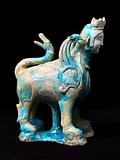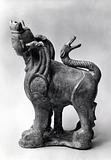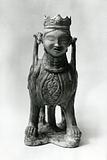This sphinx was found in Rafiqa, Raqqa’s twin city, in 1924 together with the cock (
Isl 57) and the figure of a horseman in Syria’s National Museum. As ceramic sculptures, they are unique not only in Syria, but also in the rest of the Islamic world.
They are fountain figures, and all have pipes to carry water up to the figures’ heads. The North African historian al-Maqqari wrote that the Spanish Umayyad caliph Abd al-Rahman III had a fountain made with 12 figures: a lion with a gazelle, a crocodile, a serpent, an eagle, an elephant, a dove, a falcon, a peacock, a hen, a cock, a hawk, and a vulture.
Inv. no. Isl 56
Published in:
Eva Baer: Sphinxes and harpies in medieval Islamic art: an iconographical study, Jerusalem 1965, fig. 19 and pp. 12, 15 and 22;
Ernst J. Grube: “Islamic sculpture: ceramic figurines” in Oriental art. N.S., 12:3, 1966, fig. 6, p. 168;
Vilhelm Slomann: Bicorporates: studies in revivals and migrations of art motifs, ed. Ulla Haastrup, Copenhagen 1967, vol 1, p. 47 and vol. 2, figs. 177-178;
C .L. Davids Samling. Fjerde Del : Jubilæumsskrift 1945-70, København 1970, cat.no. 2, pp. 270-271;
André Leth: Davids Samling. Islamisk kunst = The David Collection. Islamic Art, København 1975, p. 33;
Oliver Watson: “A Syrian bull: a rare Islamic figurine” in Apollo, CXIII:227, 1981, fig. 3;
Art from the World of Islam. 8th-18th century, Louisiana, Humlebæk 1987, cat.no. 82;
Kjeld von Folsach: Islamic art. The David Collection, Copenhagen 1990, cat.no.129;
Kjeld von Folsach: Fabelvæsner fra Islams Verden, Davids Samling, København 1991, cat.no. 3;
Joachim Gierlichs: Mittelalterliche Tierreliefs in Anatolien und Nordmesopotamien: Untersuchungen zur figürlichen Baudekoration der Seldschuken, Artuqiden und ihrer Nachfolger bis ins 15. Jahrhundert, Tübingen 1996, p. 49 and note 403;
Kjeld von Folsach, Torben Lundbæk and Peder Mortensen (eds.): Sultan, Shah and Great Mughal: the history and culture of the Islamic world, The National Museum, Copenhagen 1996, cat.no. 204;
Markus Hattstein and Peter Delius (eds.): Islam: art and architecture, Berlin 2000, p. 196;
Kjeld von Folsach: Art from the World of Islam in The David Collection, Copenhagen 2001, cat.no. 187;
Eric Delpont (ed.): L'Orient de Saladin: l'art des Ayyoubides: exposition présentée à l'Institut du monde arabe, Paris du 23 octobre 2001 au 10 mars 2002, Institut du monde arabe, Paris 2001, cat.no. 52, pp. 56-57;
Almut v. Gladiss (ed.): Die Dschazira: Kulturlandschaft zwischen Euphrat und Tigris, Museum für Islamische Kunst, Berlin 2006, cat.no. 6, pp. 44-46;
Abbas Daneshvari: “From Mashu to Qâf: the iconography of a Minai bowl” in Patricia L. Baker and Barbara Brends (eds.): Sifting sands, reading signs : studies in honour of professor Géza Fehérvári, London 2006, fig. 7;
Abbas Daneshvari: Of serpents and dragons in Islamic art: an iconographical study, Costa Mesa 2011, p. 172, pl. 110;
Kjeld von Folsach: “Paradise on earth: water and the Islamic garden” in John Kuhlmann Madsen, Nils Overgaard Andersen and Ingolf Thuesen (eds.): Water of life: essays from a symposium held on the occasion of Peder Mortensen's 80th birthday, Copenhagen 2016, p. 191, fig. 5;
Sheila R. Canby [et al.]: Court and cosmos: the great age of the Seljuqs, Metropolitan Museum of Art, New York, New Haven 2016, fig. 98, p. 243;
Antony Eastmond: Tamta's world: the life and encounters of a medieval noblewoman from the Middle East to Mongolia, Cambridge 2017, p. 256, fig. 87;





